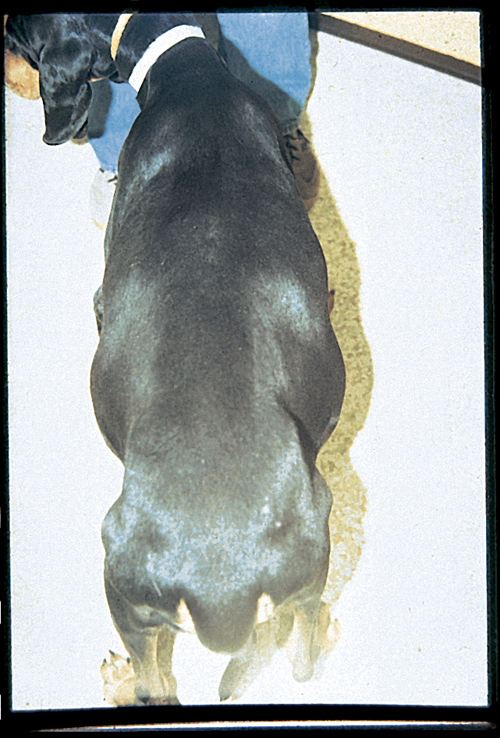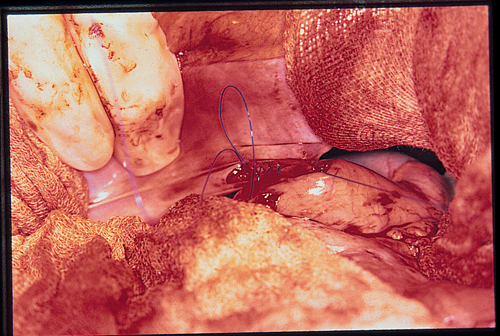Difference between revisions of "Small Animal Emergency and Critical Care Medicine Q&A 09"
Ggaitskell (talk | contribs) |
|||
| (2 intermediate revisions by one other user not shown) | |||
| Line 1: | Line 1: | ||
{{Template:Manson | {{Template:Manson | ||
|book = Small Animal Emergency and Critical Care Medicine Q&A}} | |book = Small Animal Emergency and Critical Care Medicine Q&A}} | ||
| − | + | [[File:ECC 09a.jpg|centre|500px]] | |
| + | <br> | ||
| + | [[File:ECC 09b.jpg|centre|500px]] | ||
<br /> | <br /> | ||
| Line 9: | Line 11: | ||
<FlashCard questions="3"> | <FlashCard questions="3"> | ||
| − | |q1=What are the pros and cons of the following surgical procedures for preventing gastric volvulus from recurring: circumcostal gastropexy; antral incisional gastropexy; tube gastropexy; midline abdominal closure gastropexy? | + | |q1=What are the pros and cons of the following surgical procedures for preventing gastric volvulus from recurring: |
| + | *circumcostal gastropexy; | ||
| + | *antral incisional gastropexy; | ||
| + | *tube gastropexy; | ||
| + | *midline abdominal closure gastropexy? | ||
|a1= | |a1= | ||
Circumcostal gastropexy. | Circumcostal gastropexy. | ||
| Line 23: | Line 29: | ||
:*Pros: rapid technique. | :*Pros: rapid technique. | ||
:*Cons: makes a reapproach to the cranial abdomen very difficult. | :*Cons: makes a reapproach to the cranial abdomen very difficult. | ||
| − | |l1= | + | |l1=Gastric Dilatation and Volvulus#Treatment |
|q2=What vessels are most commonly torn during a gastric dilatation/volvulus episode, and where are these located? | |q2=What vessels are most commonly torn during a gastric dilatation/volvulus episode, and where are these located? | ||
|a2= | |a2= | ||
Short gastric arteries and left epiploic artery along the greater curvature of the fundus. | Short gastric arteries and left epiploic artery along the greater curvature of the fundus. | ||
| − | |l2= | + | |l2=Monogastric Stomach - Anatomy & Physiology#Vasculature |
|q3=What surgical findings would indicate that a splenectomy is required? | |q3=What surgical findings would indicate that a splenectomy is required? | ||
|a3= | |a3= | ||
| Line 35: | Line 41: | ||
*bleeding mass; | *bleeding mass; | ||
*uncontrollable hemorrhage of the spleen. | *uncontrollable hemorrhage of the spleen. | ||
| − | |l3= | + | |l3=Gastric Dilatation and Volvulus#Treatment |
</FlashCard> | </FlashCard> | ||
| Line 41: | Line 47: | ||
rect 0 0 860 850 [[Small Animal Emergency and Critical Care Medicine Q&A 10|Small Animal Emergency and Critical Care Medicine Q&A 10]] | rect 0 0 860 850 [[Small Animal Emergency and Critical Care Medicine Q&A 10|Small Animal Emergency and Critical Care Medicine Q&A 10]] | ||
desc none}} | desc none}} | ||
| + | |||
[[Category:Small Animal Emergency and Critical Care Medicine Q&A]] | [[Category:Small Animal Emergency and Critical Care Medicine Q&A]] | ||
| − | |||
Latest revision as of 16:37, 11 October 2011
| This question was provided by Manson Publishing as part of the OVAL Project. See more Small Animal Emergency and Critical Care Medicine Q&A. |
Your triage nurse alerts you that a three-year-old, male Coonhound (40 kg) with a few hours’ history of non-productive retching and pacing has entered the hospital. Primary survey reveals poor perfusion, rapid and irregular heart rate, and a tympanic, distended cranial abdomen. A lateral radiograph reveals gastric dilatation and volvulus.
| Question | Answer | Article | |
What are the pros and cons of the following surgical procedures for preventing gastric volvulus from recurring:
|
Circumcostal gastropexy.
Antral incisional gastropexy.
Tube gastropexy.
Midline abdominal closure gastropexy.
|
Link to Article | |
| What vessels are most commonly torn during a gastric dilatation/volvulus episode, and where are these located? | Short gastric arteries and left epiploic artery along the greater curvature of the fundus. |
Link to Article | |
| What surgical findings would indicate that a splenectomy is required? |
|
Link to Article | |

